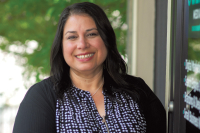The ties that bind – one high five at a time
By Garret K. Woodward • Staff writer
I had just finished my third steamed carrot when the yelling began.
It was a group of men, with faces of power and a seemingly euphoric rage. With backs to each other, their bodies pointed in every direction, chests being pounded to the point red hand marks emerged. Tongues stick out furiously in a unique and precise tribal fashion that would make even Gene Simmons question if he was doing it correctly when he was onstage.
They are the New Zealand dance troupe, and tonight they are rocking the Folkmoot cafeteria where 300 hungry dancers and musicians refuel after a hard day of performing during the whirlwind international dance and music extravaganza.
In keeping with 29 years of Folkmoot tradition, each night of the two-week festival, one country is picked as the host of an after-party held at Folkmoot’s headquarters. Here, at a former elementary school in Waynesville that serves as a dorm for the visiting groups, the performers postpone sleep to partake in the late night exchange of culture, games, dance techniques and language.
Growing up, my grandfather, who was a World War II veteran of the Pacific theater, always said the greatest place he had ever been to was New Zealand and areas surrounding. He spoke of the mesmerizing geography, people and culture. He was a man who saw the value of the little things inside the big picture of life. He said it was a beautiful world out there, and we’re lucky to live in it.
Related Items
With a culture as ancient and rich as mankind itself, the New Zealand ensemble relies on the finest instrument there is – the human body. Using their hands to slap, clap and wave, they twirl and shake, one moment shouting the native Maori words, another moment singing with cradling voices.
“Our dance genre is founded on the base of culture, and a lot of modern instruments weren’t introduced yet,” said Tupe Lualua, a performing arts tutor for New Zealand. “We stay true to the essence of our culture, which is our bodies and our voices.”
Bellies full from dinner (a fourth meal is provided late in the evening due to the enormous amount of energy burned while onstage), the enthusiastic audience (filled with other international performers, local volunteers and curious onlookers) merged with the group.
They were taught a native dance that started on the ground (legs crossed) and morphed into an array of hand claps, elbow thrusts and head bobbles, ultimately ending up with everyone jumping to their feet and yelling words of encouragement.
Soon, a sea of people was all moving together; everyone smiling. There they were, teenagers from every corner of the globe, standing as one, a place where there were no borders, language differences or societal conflicts. It seems the only true currency here is a high-five of appreciation between foreign entities, now fast friends thanks to the common bond of rhythm and performance.
“It’s not really much of a job to do this if you love it,” Lualua said. “We’re sharing cultures. You might not speak the language of the other person, but at the end of the day, it’s the soul, the dance, the emotion and the passion that weaves us all together. No matter where we’re from, we are all human.”
Rallying back to the stage, the group gathers around and begins to chant, guitars and log drums conjuring the spirits above. A lone dancer slides onto the floor. Circling around with hands high in the air, Tehau Winitana summons her talents and pride.
“When I’m out there, I just zone out and lose myself within the lyrics and the music,” she said afterwards. “It’s an intense feeling, something you can feel out there, something a person in the audience can feel too.”
She whirls along the invisible line between audience and performer. The primal beat echoes off the walls and into the hearts of those open to the true splendor and essence of Folkmoot.
“I think this is a great way to share my culture with the world and vice-versa,” Winitana said. “For a lot of Pacific island and Polynesian cultures, body percussion and vocals are probably the most important aspect of the dance. I’m fully immersed in this, and that goes for a lot of the dancers here. We grow up dancing. It’s in the families and the culture. I absolutely love being here. I hope to come back again.”
As beads of sweat trickle down foreheads, innumerable faces scatter through a maze of hallways and stairwells. Cafeteria lights are shut off row by row. A few straggler dirty dishes and cups are collected. The fast friends giggle and prance towards their slumber quarters. It’s now the wee hours of Saturday morning. Eyelids grow heavy with dreams hopefully as peaceful as the scenes that unfolded this evening.
“Now, I truly understand the meaning of southern hospitality,” Lualua said. “All the friendly people and the incredible southern food. We’ll be lucky if we’re the same size when we go back home.”
Well grandpa, you were right, it’s a beautiful world out there, and we’re lucky to live in it.









